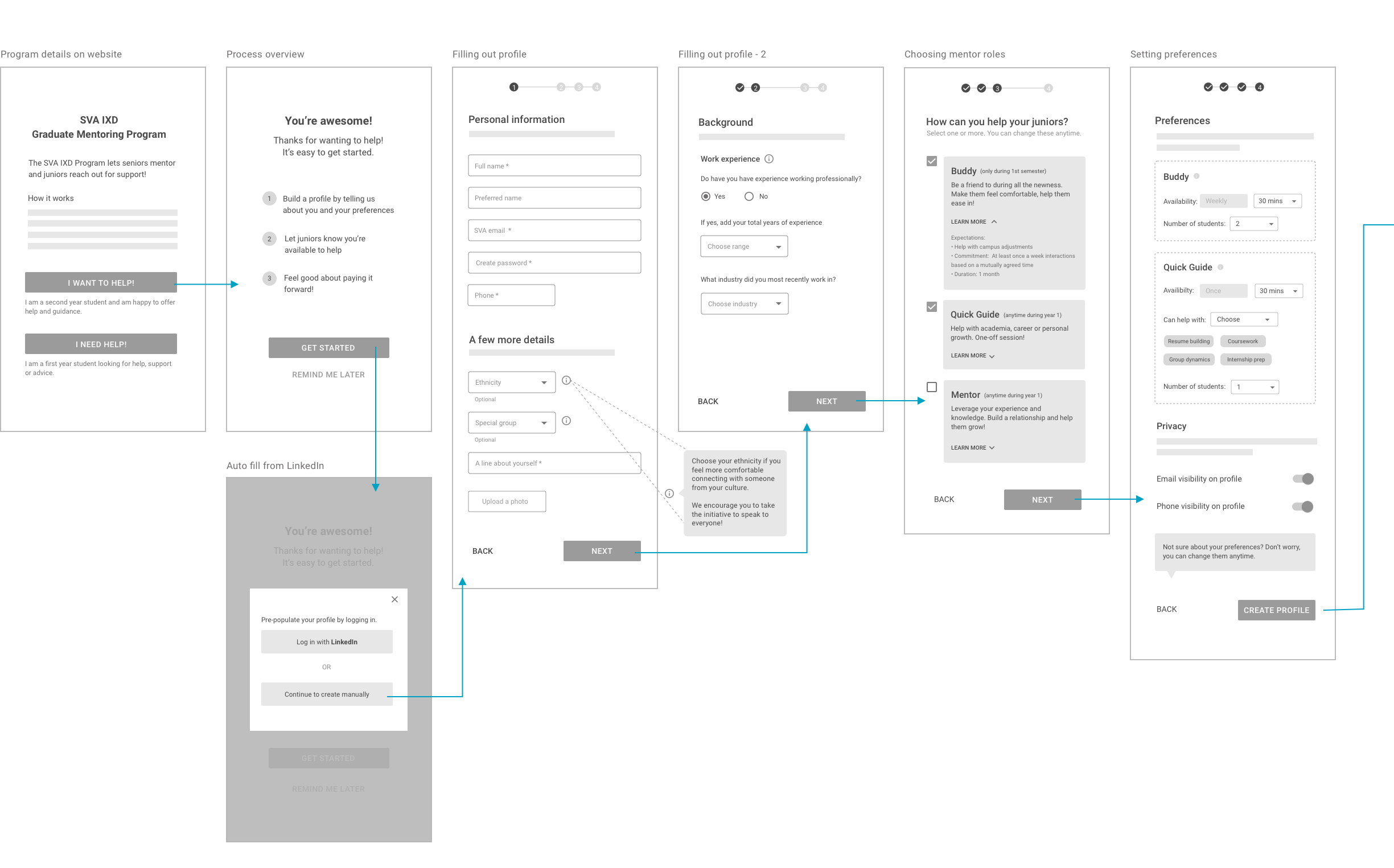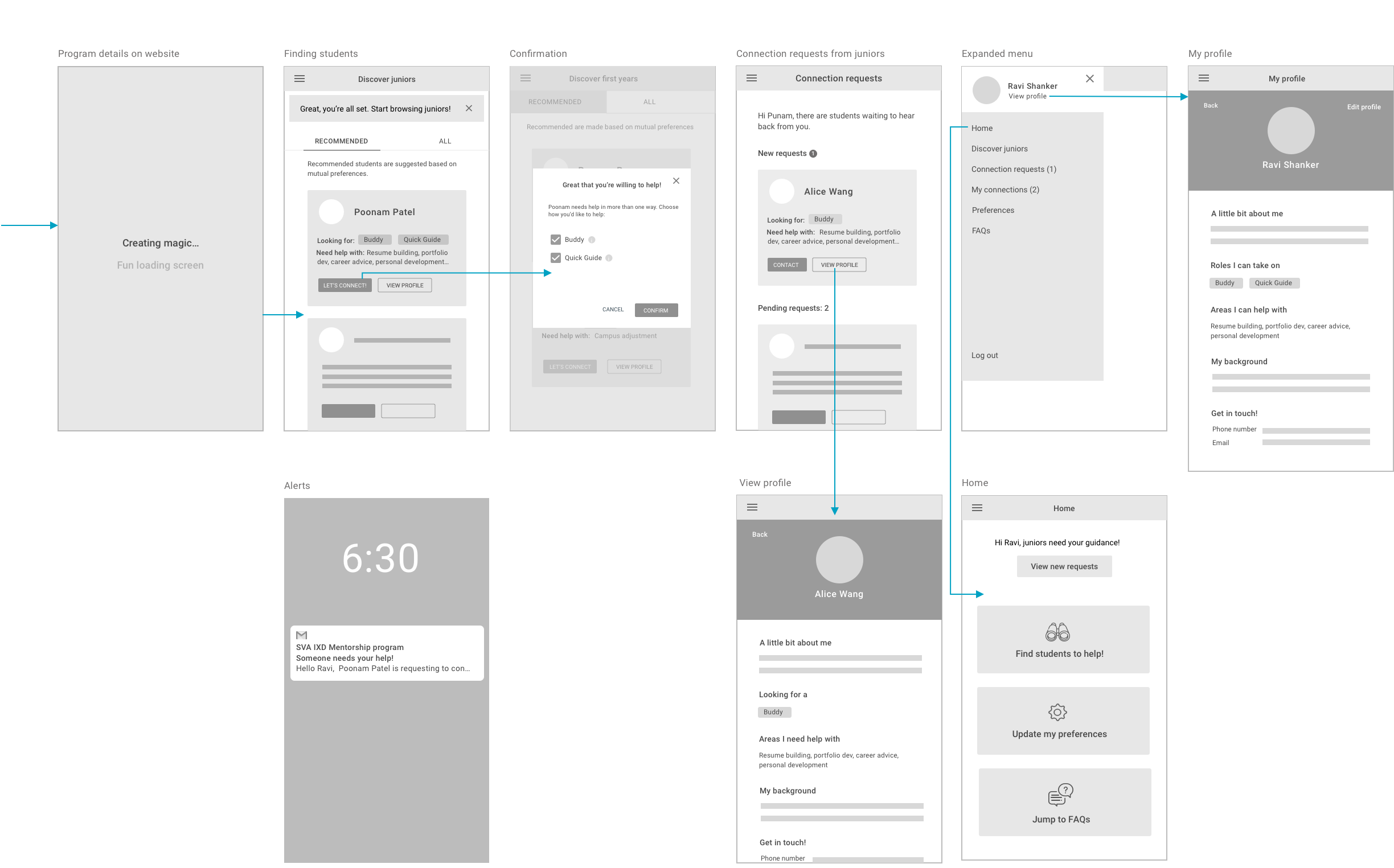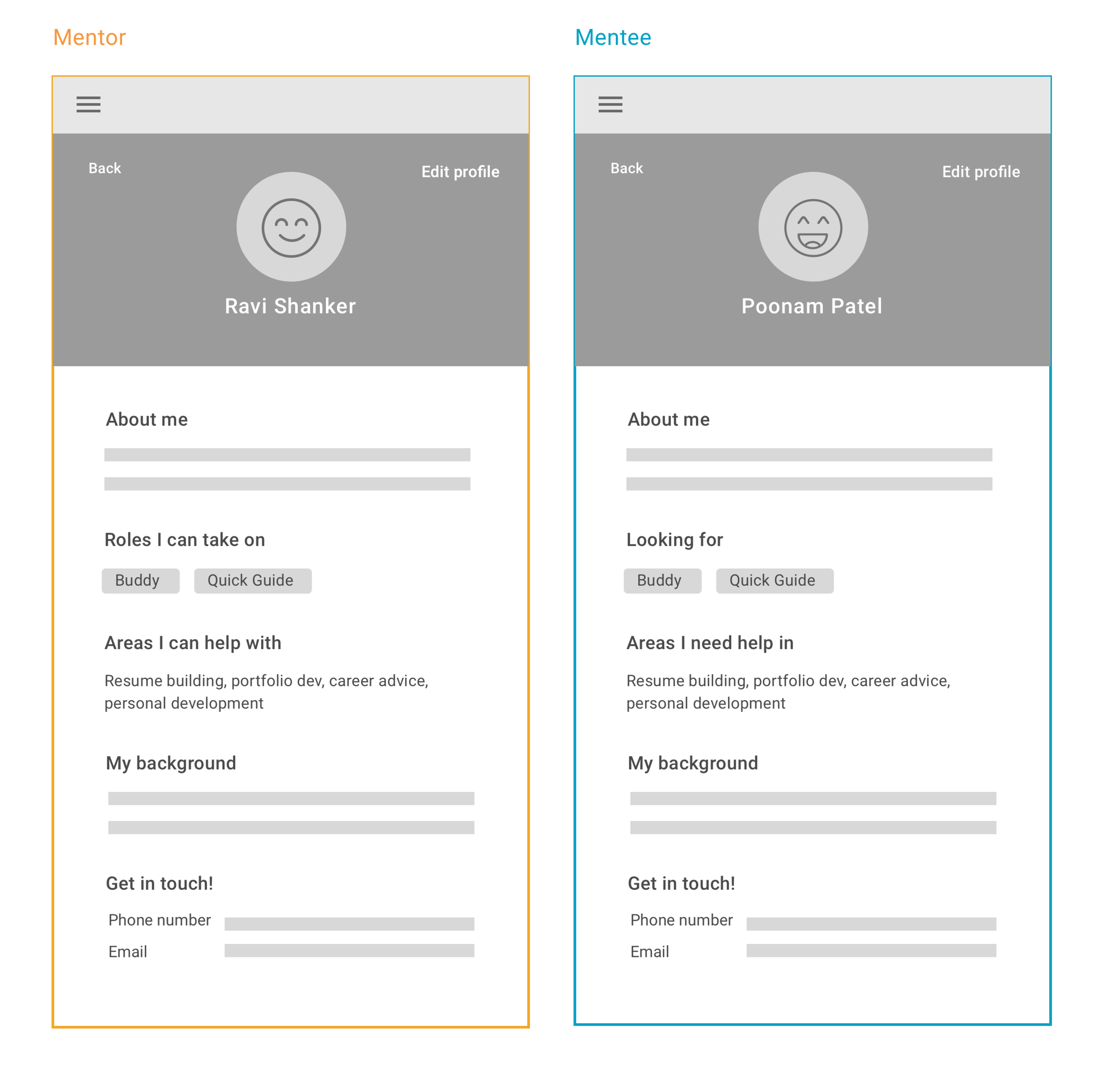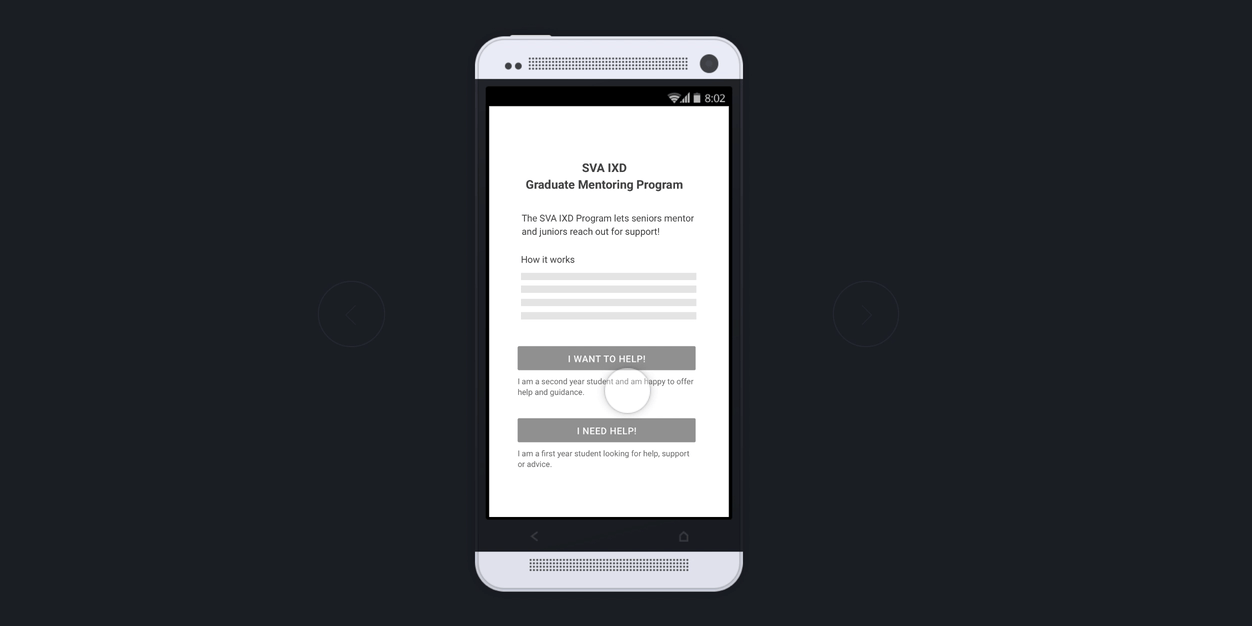
The MFA IxD Support Squad
#1WeekDesignSprint #CaseStudy #ProductDesign #UI/UX
Overview
At the graduate programs at the School of Visual Arts (SVA), there lacked mentorship for incoming students.
There was an opportunity to strengthen the community at the school by encouraging seniors to connect with new students and help them adjust to campus life. Excited to solve this problem, I carried out a 1-week design sprint inspired by a design challenge prompt to find a solution.
Design process
I followed an iterative process for this exercise:
Scope and constraints
I scoped this exercise down to a cater to a specific audience: MFA Interaction Design (IxD) students. I did this for two reasons:
From a business perspective, I wanted to test the concept with a smaller audience, and later, scale to the whole school.
I believe mentors and mentees from the same department would connect more meaningfully due shared experiences at at the same school and part of career journey.
Kicking-off with research
I began the process with user interviews, followed by some desk research on SVA and other schools.
Inclusive user interviews
To kick off research, I interviewed both kinds of users to understand the kind of guidance they needed or help they could offer :
3 first years (an introvert, an extrovert and someone from the LGBT group)
2 second years (an introvert and an extrovert)
I chose to interview a diverse audience to consider the needs of different personality types, cultural groups and communities.
Researching mentorship at SVA & other schools
I looked up the meaning of mentorship to make sure I understood the role correctly. I also did some research on existing mentoring initiatives at SVA.
Besides SVA, I looked at other university mentorship programs to understand how they facilitate mentorship.
Making sense of the research…
I put it my research findings together in four categories: successes, pain points, needs and considerations.
Key insights
Seniors are willing to “pay it forward” but don’t proactively offer help
Juniors often hesitate to reach out and feel that the program lacks a culture of support .
The kind of mentorship juniors need varies depending on where they are in the program journey.
Seniors and juniors find mentorship more valuable when they can connect with the other person in some way.
Seniors and juniors value setting expectations upfront for the mentor-mentee relationship and being invested in it.
Revised problem statement
Based on my insights, it became clear that the pressing problem was the barrier between juniors and seniors. And so I narrowed down on the problem statement:
How might we get more juniors and seniors to reach out to each other?
Goals
Based on the problem statement, I set three corresponding goals:
Provide an easy, friendly and effective way for seniors and juniors to offer and receive mentorship.
Foster more meaningful engagement between both based on their individual needs and expectations.
Promote a culture of help and support. Break barriers. “We’re here if you need us”.
Solution: Exploring ideas and flows
I did a few rounds of flow sketches and tested and validated them with users.
Pictured: Mentor flow
Solution: Features based on trade-offs
Based on my conversations with users, I weighed pros and cons and finalized on a few directions:
Why? Research showed that building a culture is a two-way effort, so I applied that learning to the mentee-mentor initiative. This approach helps build a culture, and increases the probability of more connections. It also sets us in the direction to achieve goal #1 and #3.
Why not the other? When only one side reaches out to the other, there’s no accountability. This makes it a hit or miss. One-sided relationships can also make one side feel more entitled depending on who’s reaching out.
Why? As seen in the insights, juniors need help with different things at different stages in their school journey, so having various types of mentorship to choose from accounts for their needs throughout.
Also, considering the needs of seniors, they have the flexibility to offer help in ways they feel comfortable with and have time for. This helps us towards reaching goals #1 and #2.
Why not the other? Offering just one or even two kinds of mentorship program doesn’t take into account all the needs of both the types of users.
Why? Juniors and seniors want to learn more about each other before investing in a mentor-mentee relationship. This sets us in the right direction for goal #2.
Why not the other? Through my user interview, I learnt that while it takes care of the part of having to reach out to someone, it most often it doesn’t often end up being useful due to lack of connection between mentor and mentee.
Why? Giving juniors and seniors an option to choose from multiple matched profiles allows them to feel empowered about the choices they make while also feeling convinced having learnt more about the person on their own. This also helps to towards achieving goal #2.
Why not the other? Tinder-like one-by-one matching systems work great for a larger pool of people; with a small pool of 38 students, it may cause students to be left out or pressured out make a choice every time.
Wireframes & features
I incorporated the feedback from my first round of testing into digital, more detailed wireframes. I decided to add more detail in my wireframes to give my users more context during testing.
Find wireframes and user flow for mentors aka seniors below. Most of the mentee’s flow is the same, find differentiated screens in the next section.
Zooming into important bits
Onboarding: Considering the needs of seniors and juniors
Onboarding is one of the important parts of this experience: getting buy-in from users. As part of this flow, seniors and juniors create a profile, select the help they can offer or need and add preferences based on what works for them. This very flow begins to fulfill goals #1, #2 and #3.
To make the profile less tedious to fill out and prevent drop offs, I gave users the option to pre-populate information from LinkedIn.
2. A customised mentorship model for both
Defining mentorship in a way that resonated with both the users was crucial. I put together three types mentorship roles based on the kind of help juniors needed and seniors could provide.
Initially some roles weren’t as clear to users, so I worked through a couple of iterations to make them distinguished and have clear explanations.
Outcome? The roles strongly resonated with both my user types - seniors were happy to offer help in at least one way and juniors loved how they strongly fulfilled their needs.
3. Flexibility with preferences
I gave seniors and juniors the opportunity to customise how they wanted to offer or receive help. This increases the probability of more students participating in the initiative.
I also strategically gave the mentor more customisation options to make it easier for them to offer help.
I also included privacy setting so users could control how they wanted to be reached out to.
4. Meaningful connections with algorithm-based recommendations
I strategised how students would be recommended to each other. With a strength of only 20 students in each class, the algorithm would use any selected mentorship roles, “need help with” tags or industry tags to match students.
Mentors would always see more matches than mentees, to reinforce the number of juniors who needed help.
5. A friendly profile that encourages students to connect
I designed the profile to show relevant information giving mentors and mentees the opportunity to find the right match based on shared experiences or goals.
The platform was also designed to have a friendly and supportive tone so seniors and juniors can approach each other more easily.
Testing with prototypes
I conducted a second round of testing with seniors and juniors using digital prototypes. I tested with four users and used the feedback to inform my final designs.
Hi-fidelity designs
Considering this platform was going to be on SVA IXD’s website , I retained its simplicity and colour palette. I took the liberty of adding fun bits to help set a more friendly tone for how students saw each other.
Based on popular usage of phones among students, I carried out the design process with a mobile-first approach. While desktop screens are not showcased here, the website is designed to be responsive.

Reflections
This exercise really taught me to take a step back and think about the bigger goals of a product. It’s often easy to get caught up in research and the finer details.
I also learnt a great deal about writing, storytelling, talking about the “whys” and reinforcing clear objectives.
You came this far! Thanks for reviewing 🌺
















